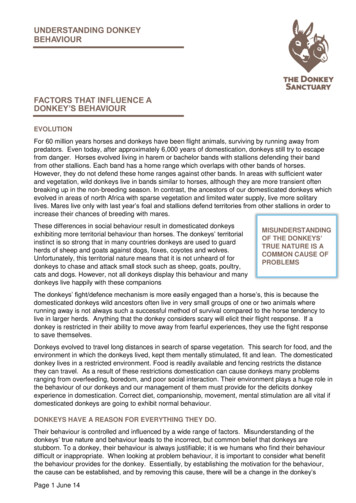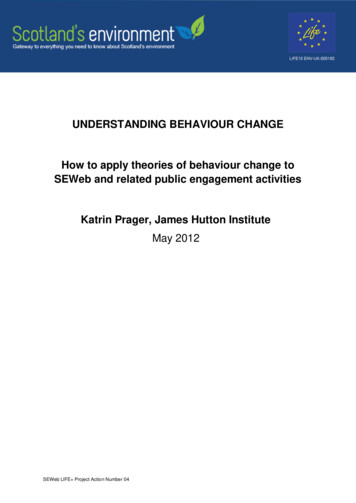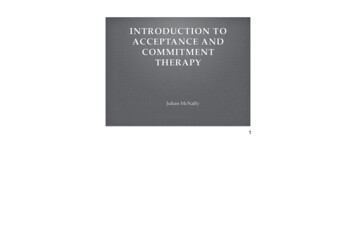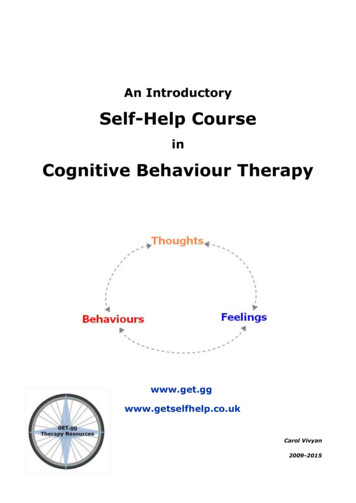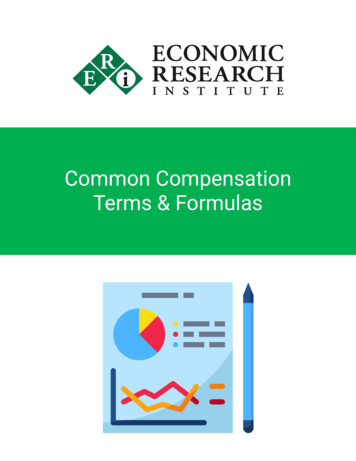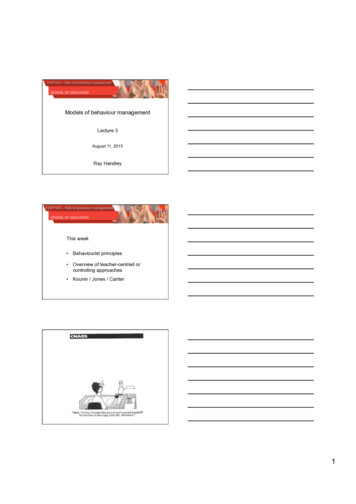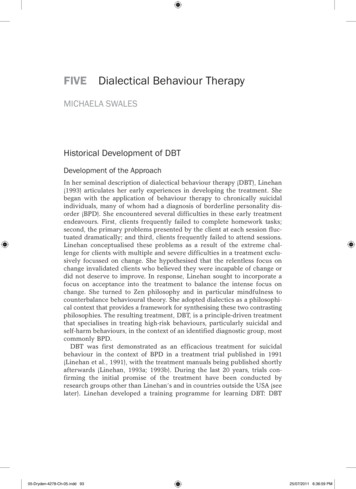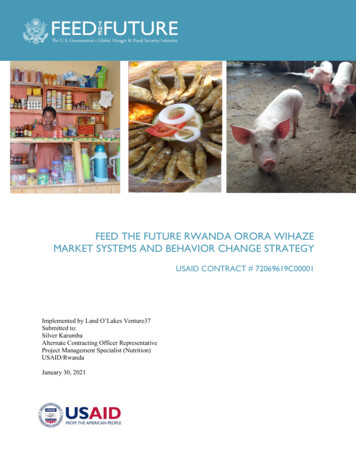
Transcription
SilFEED THE FUTURE RWANDA ORORA WIHAZEMARKET SYSTEMS AND BEHAVIOR CHANGE STRATEGYUSAID CONTRACT # 72069619C00001Implemented by Land O’Lakes Venture37Submitted to:Silver KarumbaAlternate Contracting Officer RepresentativeProject Management Specialist (Nutrition)USAID/RwandaJanuary 30, 2021
ContentsOverview of Orora Wihaze’s Goals and Strategic Objectives6Overview of Core Market ActorsOverview of Supporting FunctionsOverview of Rules and Regulations789Core Value Chain Constraints PrioritizationCore Consumption Factors PrioritizationSummary of Year 2 Strategic Priorities12216619OverviewIntervention 1: Development of ASF productionIntervention 2: Development of end market accessIntervention 3: Development of financial services marketIntervention 4: Development of nutrition extensionIntervention 5: Development of ASF product marketIntervention 6: Development of women empowerment programming2002442631343841PoultryPorkFishSheep and Goat44445546472
ACRONYMSASFAnimal-Source FoodsCSOCivil Society OrganizationCU2Children Under 2 Years OldGoRGovernment of RwandaFtFFeed the Future (USAID)MADMinimum Acceptable DietMINAGRIMinistry of Agriculture (GoR)MSDMarket System DevelopmentMSMEsMicro, Small, and Medium-sized EnterprisesNECDPNational Early Childhood Development ProgramNGONon-Governmental OrganizationPPPPublic-Private Partnership(s)PWDPerson with DisabilitiesSBCSocial and Behavior ChangeSBCCSocial and Behavior Change CommunicationSILCsSaving and Internal Lending CommunitiesUSAIDU.S. Agency for International Development (Rwanda Mission)Venture37Land O’Lakes Venture37VNSVillage Nutrition Schools3
IntroductionWhile the Market Systems Development Design and Implementation Manual outlines how the OroraWihaze Activity will be implemented, describing the processes that Orora Wihaze follows to identify anddynamically launch activities and partnerships throughout its implementation, this Market Systems andBehavior Change Strategy (the Orora Wihaze Strategy) explains why Orora Wihaze is implementing theproposed interventions and their underlying activities. This document has been designed to provide thefollowing insights: An understanding of the supply and demand forces that shape the animal-source foods (ASF)market system. An overview of the issues constraining the ASF market system and which core market actors,supporting functions, and/or rules and regulations might be underperforming and/or solve theconstraints. An overview of the constraints that shape consumer demand and consumption of ASF that OroraWihaze will need to address directly with consumers and through market system adjustments tomeet consumers’ needs, particularly those of low-income consumers. Priority areas for intervention, which are important because while the failures in the ASF marketsystem are many, Orora Wihaze has limited resources and only five years to implement. Links between the prioritized intervention areas and the Activity’s goals.The Orora Wihaze Strategy aligns with four essential market system development (MSD) design principles: Adaptability: Is flexible and allows for the portfolio and the overall strategic approach to evolveas Orora Wihaze responds to evolving market conditions and learns from its implementation. Accountability: Provides clarity to both Orora Wihaze and USAID on why activities are beingdesigned and implemented. Strategic clarity: Clearly explains how interventions, sub-interventions, and activities are workingtogether to achieve the overall goals of Orora Wihaze. Simplicity: Has processes that are simple to follow and do not overburden the implementing teamwith lengthy bureaucracy and paperwork.The objectives, approach, and preliminary priority interventions were included in the Performance WorkStatement incorporated as Section C in the USAID contract. This document is thus an initial example of howthe Orora Wihaze Strategy will evolve. This Strategy draws from the experience and knowledge gained duringthe first 15 months of implementation of the Activity, engagement with market actors, and the primaryresearch conducted, such as the Market Systems Baseline, the Consumption Study, and the Gender and SocialInclusion Integration Strategy.The Orora Wihaze Strategy is, therefore, a working document that will evolve and be updated (i) asinterventions are designed and implemented, (ii) as the Activity learns from its implementation, and (iii) asknowledge is gained from additional primary research. Orora Wihaze will maintain a document developmentand change log to track each iteration of the Strategy. This is illustrated in Table 1 below.4
This Strategy document is structured in the following way: Section 1: Introduction. Explains the purpose of the Orora Wihaze Strategy. Section 2: Orora Wihaze – Activity Overview. Offers a summary of the Orora Wihaze objectives. Section 3: The Rwandan ASF Market System. Provides a graphic and an overview of the keyactors in the ASF market system. Section 4: Prioritization. Provides an analysis of the issues constraining the ASF market systemand the behavioral factors shaping consumer and household ASF behavior. This section alsohighlights which constraints and behavioral factors should be prioritized by Orora Wihaze. Section 5: The Orora Wihaze Portfolio. Provides an overview of the Orora Wihazeimplementation portfolio, including a detailed look at the interventions and sub-interventionsproposed.Table 1: Illustrative document development plan and change logDateJune 30, 2020DetailAuthorsSubmission of Market Systems and Behavior Change Strategy(Orora Wihaze Strategy)Orora Wihaze team,Document changes, add detail about market actors and marketincluding the activityfailures, and update the approach and priority of objectives thatmanagement, MSDwere incorporated into the Performance Work Statement (Section advisors, and DistrictC in the USAID Orora Wihaze Contract):Portfolio Managers andDistrict Nutrition Renamed intervention 2.1 from “Improve reach ofSpecialistsaggregation models” to “Strengthen market linkagesbetween producers and formal buyers”Update to the Orora Wihaze Strategy for learnings and qualitativedata and facts gathered in the Consumption Study which willfocus on household and intra-household dynamics concerningASF.Key changes made:January 29, 2021 Updated Section 2 – Activity Overview to highlight theprogram’s focus on behavior changeRevised the consumption factors tableAdded Year 2 strategic priorities (see Section 4)Expanded portfolio table (see Table 4) to include theASF product focus and impact pathwaysUpdated all intervention strategiesIncluded activity pipeline table to each sub-interventionOrora Wihaze teamOrora Wihaze – Activity OverviewThe Orora Wihaze Activity is a USAID-funded 5-year project. Orora Wihaze, translated to “Raise Animalsfor Self-Sufficiency” in English, works with local partners and various private sector actors in Rwanda to5
strengthen the ASF market system. The goal is to sustainably increase the availability of, access to, andconsumption of ASF through the development of a profitable market. Orora Wihaze’s target beneficiaries arelow-income ASF producers and all consumer households, but especially those households with young childrenand women of reproductive age, across eight administrative districts: Burera, Gakenke, Nyamagabe,Nyamasheke, Rutsiro, Ngororero, Kayonza, and Ngoma. The Activity will achieve its goal by addressing twoobjectives: (i) strengthening inclusive private sector led ASF value chains, specifically small ruminants (goatand sheep), fish, pigs and chicken, and (ii) increasing the demand for and consumption of ASF by women andchildren. The Activity is designed to specifically target women, youth, and persons with disabilities (PWD)for inclusion in the ASF market and the families with women of reproductive age and children under 24months of age for improved ASF consumption.With an eye toward accelerating uptake and sustainability of new or modified behaviors across the marketsystem, Orora Wihaze will apply a behavioral analysis to support prioritization beginning with the articulationof consumer needs to ensure that market system priorities address need to boost consumption. Subsequently,as the key behaviors are articulated for specific market actors to enhance production, marketing, orconsumption, a behavioral analysis will be undertaken similar to that started here for consumers to ensure thatthe full range of behavior change actions are used to improve outcomes.The Activity may partner with and support larger-scale producers or other market actors that are not lowincome producers for the purpose of strengthening the value chain, and it will do so with the ultimate goal ofimproving the income and/or nutrition of poor households.Overview of Orora Wihaze’s Goals and Strategic ObjectivesThe ultimate goal of Orora Wihaze is to sustainably increase the availability of, access to, and ultimately theconsumption of animal-sourced foods in Rwanda through the development of a profitable and consumermarket and facilitating a shift in consumer behavior.The three indicators that Orora Wihaze is expected to report against to demonstrate the achievement of itsgoals are: Number of households with incomes increased by at least 30% Percent of children 6-23 months receiving a minimum acceptable diet (MAD) Percent of women of reproductive age (15-49) consuming a diet of minimum diversity (MDDW)Orora Wihaze aims to achieve its impact goals by following two overlapping strategic objectives: Objective 1: Private sector led ASF value chains strengthened Objective 2: Increase demand for ASF consumption for women and childrenThrough the first objective, Orora Wihaze will aim to leverage the power of the private sector to facilitatetransformational change in how market actors produce and exchange ASF products. This could mean workingwith market actors to improve access to and use of inputs, access to knowledge and agricultural extensionservices, ASF product development skills, linkages between producers and end markets, and access to finance.Where necessary, Orora Wihaze will also work with public actors to facilitate improvements to the policyenvironment to enable private sector-led transformation.Through the second objective, Orora Wihaze will ensure that its interventions are designed to increaseconsumer demand for ASF. This means ensuring that the market system is responsive to consumer needs formore affordable and appealing products and that consumer behaviors (among Orora Wihaze participantpopulation) are aligned to support the responsive market value chain actions. These considerations in buildinga responsive and sustainable market include which value chains make the most sense immediately and intothe future and which structural factors should be prioritized during the facilitation of private sector ledtransformation to improve the affordability and availability of ASF in rural areas. In addressing consumer6
utilization of ASF in daily diets, beyond the structural factors there are multiple social factors which centerprimarily on a range of gender dynamics within and outside of the household and societal stratification thathas led to ASF being seen as food for wealthy people and not necessary in diet of poorer people. Additionally,there are knowledge and skill issues arising from unfamiliarity with certain ASF, ideas about their value orcooking properties, and with lack of confidence in how to prepare them. Orora Wihaze will therefore identifymultiple entry points to drive consumer behavior change, such as working with the Government of Rwandaand key NGO partners to improve nutrition and food knowledge of caregivers and other household members,to support improved household resource management especially tied to food procurement, women’sempowerment and gender equity, and capacity development in food preparation and household storage.The Rwandan ASF Market SystemFigure 1: The Orora Wihaze market systemFigure 1 provides a graphical representation of theASF market sytem depicting three elements:A core function that includes the market actorsleading the production, processing, retail, andconsumption of ASF. As in all markets dominatedby supply and demand dynamics, supply marketforces determine ASF demand, and consumerdemand shapes supply.Supporting functions that enable the core marketactors to efficiently produce, operate andexchange products, so that they meet theobjectives of Orora Wihaze.Rules and regulations that enable, police, andregulate the core market actors.It is important to note that the ASF market system includes supporting functions and rules and regulations thatsupport and enable all core market actors to meet Orora Wihaze’s goals, inclusive of consumers. This thereforeincludes market actors that are involved in influencing and strengthening nutrition knowledge of households,which can affect consumer demand for ASF.In this Activity, the market system described above will be specifically applied across four value chains: Poultry products (the consumer behavior assessment makes the further distinction between eggsand poultry meat) Swine products Goat and sheep products (such as goat meat and goat milk) Fish productsWhile the four value chains listed above have some similarities, including overlapping market actors and oftensimilar production and trading practices, there are differences that must be taken into account both during thediagnostic process as well as during the identification of intervention opportunities and solutions and thedesign of activities.Overview of Core Market ActorsThe market actors that form the core market function of the ASF system are the following:7
Producers. Depending on the ASF product, this can include micro-backyard farmers, small/mediumsized farmers, and/or large commercial farmers. Farmer groups, cooperatives, and associations. This includes farmer groups and cooperativesregistered under the Rwanda Cooperative Agency. These actors are often responsible for managingproduction and marketing activities, aggregating, and coordinating the efforts and financialcontribution of different farmer groups. Collectors and transporters. These actors play a different role depending on the ASF product, butgenerally include traders that operate between producers and end-markets, who are responsible forcollecting the product at the farm gate and supplying retail markets. These traders take mark-ups ofdifferent degrees, depending on the market, and in some situations invest in transport infrastructureincluding cold chains. Primary market traders. These actors are involved in sales channels closer to where productiontakes place, such as local market sellers and neighborhood kiosks. Processors. Butchers and abattoirs are the main market actors involved in the transformation ofproducts and value addition of ASF products. Exporters. Exporters play a key role in the ASF market system by channeling production toneighboring countries. Few producers export products themselves, and most exporters rely on smallscale cross border traders, such as Handicapes (traders exempt from formal tax) and ChoraChora(informal facilitators to move goods across borders), and are coordinated by trader associations, tradefacilitators, and large transporters. Retailers. There are a multitude of retail channels for ASF products across Rwanda, some of whichare more relevant to some ASF products than others. Retail channels can include restaurants and bars,large supermarkets, hotels, and schools. Consumers. Orora Wihaze targets low-income households residing in eight priority districts acrossRwanda. The Activity also specifically targets households with women of reproductive age and youngchildren. Across all ASF products, consumers often overlap with producers, because a largeproportion of households in Rwanda raise backyard animals, either for their own personalconsumption or for sale.How the market actors described above produce, exchange, and consume varies according to ASF producttype, and therefore, the specific dynamics should be analyzed individually. Detailed maps that show theserelationships can be seen in Appendix I, Core Market Actor Maps.Overview of Supporting FunctionsThe key supporting functions to the ASF market system are the following: Breeding. Breeders supply producers with more productive breeds. Breeders vary by ASF productsand can include hatcheries and brooders for the production of poultry products, fingerling hatcheriesfor the production of fish, and breeding services and centers to support the production of shoats andpigs. In some ASF products, namely poultry and fish, producers sometimes diversify and work asbreeders too. Input supply. These include a multitude of actors that sell inputs that are critical to the ASFproduction process. This includes market actors that produce and/or sell feed, veterinary drugs, andproduction and processing tools and equipment. Hygiene and health. These primarily include veterinary services, such as para-vet networks andpublic and private pharmacies. Financial services. These can include a variety of institutions that support the various market actorswith services and products that improve their ability to borrow or to manage and control theirresources more effectively. These can include banks, microfinance institutions, mobile financial8
providers, savings groups, and other financial institutions or mechanisms such as the rural investmentfacility, the agricultural guarantee fund, and the women guarantee fund. Information and training. These include those actors involved in providing a wide range ofinformation and knowledge to support the core market actors meet the objectives of Orora Wihaze.This can include improving the production of ASF, the efficient exchange of ASF products, and theconsumption as well. Actors that Orora Wihaze could engage with include input suppliers, financialservices providers, and Ministry of Agriculture extension workers, as well as community volunteernetworks such as Community Health Workers (CHWs), private firms, or civil society organizations(CSOs) who play the role of scaling effective evidence-based ASF nutrition messaging, including safehandling of ASF.Overview of Rules and RegulationsAs Rwanda urbanizes and income for many households increases, the demand for safe and high quality ASFproducts and related services is increasing. This increasing demand for quality ASF products and relatedservices is leading to proliferation of agro-food industries including ASF processing and marketing companiesand service providers to the industry. Many of these agro-food industry businesses seek standardization andconformity assessment services and are willing to provide and market competitive goods and services andgain the confidence of consumers. One of the key important functions of the Government of Rwanda (GoR)is to create an enabling environment in which ASF-based enterprises operate by putting in place clear policy,institutional, and regulatory frameworks and by introducing and enforcing standards to foster a competitiveenvironment for private sector enterprises in the sector, thereby increasing efficiency in the economy to theultimate benefit of both consumers and producers.In respect to the enabling environment for the ASF market system, the GoR regulates the production, supply,distribution, and marketing of animal products and animal feeds in an effort to ensure biosecurity and biosafetyand to, consequently, facilitate the trade and distribution of these products in Rwanda, within the Central andEast Africa region, and for export to other markets.Government of Rwanda’s policy and strategies. The GoR’s commitment to supporting the ASF marketsystem is well manifested in numerous policy and strategy frameworks put in place. Some of these policy andstrategy frameworks include the National Strategy for Transformation (NST1), the National AgriculturalPolicy (NAP 2018) and its related Strategic Plan for Agriculture Transformation (PSTA4-2018-2024). Thesepolicies provide a clear enabling environment to strengthen private sector led ASF value chains. The policyand plans, if implemented and enforced, should facilitate increases in ASF productivity and production levelsand encourage introduction of improved breeds, sourcing quality animal feed, and fighting animal diseases.As far as ASF market system is concerned, the policy and strategy frameworks support an inclusive andprofitable ASF market system which guarantees reliable access to affordable and healthy diets for theRwandan consumers in order to meet national objectives on poverty reduction, food security, and nutritionthrough strengthening market linkages throughout the value chain, increasing awareness and access to healthydiets for the consumer, promoting food safety and access to higher end markets with expanded access to SPSand quality standards certification.Subsidies: The national agricultural policy and strategy frameworks have created an enabling environmentthat is conducive for private sector entities to pilot new innovative technologies and business modelsparticularly in the area of input production and distribution that should increase the quantity and quality ofproduce and animal resources. One of the key financing mechanisms used by GoR is a subsidy and incentivepolicy to attract private capital that encourages investment in livestock input, equipment and materialsacquisition where for example, livestock vaccines are subsidized almost at 100% and livestock (cattle, poultryand pig) product is subsidized at 40%. In addition, in accordance to the law N 37/2012 of 09/11/2012establishing the value added tax, the Minister of Finance and Economic Planning has established a list ofagricultural and livestock inputs, materials and equipment exempt from value added tax including, breedinganimals, crop by-products an industrial food wasted used in animal feeds, mineral supplements for animalfeedings, vet pharmaceutical products, vet materials, livestock materials, insemination material inputs, etc.9
Furthermore, the law Nº 016/2018 of 13/04/2018 establishing taxes on income, in Article 21 stipulates thatagriculture and livestock income is tax exempt if it does not exceed twelve million Rwanda francs (Rwf12,000,000) in a tax period.Hygiene and standards: For decades, Rwanda joined different global, African continental, and regionaltrading systems/blocks such as WTO, EAC, COMESA, CPGL, etc. to support its sustainable development.These trading systems opened access for the country to wider markets and ultimately increasing demand forsafe and quality products and services. For Rwanda to have competitive products and services and fullyparticipate in regional and international trade, it adopted the National Quality Policy in 2010, and later revisedin 2018, to support the restructuring and reengineering of its technical regulatory framework so the nationalregulations are harmonized with those of its trading partners. The National Quality Policy also provides a clearframework to cater for technological and quality needs; to minimize environmental, health, and safety risks;and to improve hygiene and standards in ASF market system. A number of legal instruments (laws, regulationsand orders) have been put in place to substantially promote and regulate standards and hygiene in the ASFmarket system. Key among these include a law governing the use of agrochemicals (law No. 30/2012 of01/08/2012); a law relating to competition and consumer protection (law no.36/2012 of 21/09/2012); aministerial order on transport and trade of meat (No. 013/11.30 of 18/11/2010); a ministerial order on animalslaughtering and meat inspection (No. 012/11.30 of 18/11/2010); a ministerial order on stray cattle and otherdomestic animals (No. 009/11.30 of 18/11/2010); a ministerial order determining the organization ofveterinary pharmacy practice (No. 008/11.30 of 18/11/2010); and a ministerial instructions regulating privatecertification bodies offering product and system certification (N 17/2012 of 10/07/2012).Investment rules: Since 2009, the GoR adopted the National Public Investment Policy to guide theGovernment in its investment program. This policy was reviewed in 2017 and focuses on improving efficiencyand efficacy of the public investment portfolio and increasing the coordination between public and privateinvestments, including encouraging Public Private Partnerships. Complementary to this policy, the StrategicPlan for Agriculture Transformation (PSTA4) serves as Rwanda’s Agriculture Sector Investment Plan. Theplan outlines priority investments in the agriculture sector and creates an enabling business environment andfacilitates private sector investment in higher value chains including poultry, pork, and fisheries, etc. Inaddition, the GoR established legal frameworks for the management of national investment. These include thelaw governing public private partnerships (Nº 14/2016 of 02/05/2016); the prime minister’s order determiningthe functioning of the Public Private Partnership (PPP) Steering Committee that was approved by Cabinet on03/02/2017; the organic law on state finances and property (N 12/2013/OL of 12/09/2013); and a ministerialorder relating to financial regulations (N 001/16/10/TC of 26/01/2016).Export rules: Rwanda’s exports are evermore being updated to focus on attaining structural shifts in thenature and composition of exported products. The emphasis is on high-value and diversified products,including ASF products. Several policy and regulation frameworks have also been put in place to supportprivate sector operators to encourage increased diversification of ASF products for domestic and exportmarkets. Some of these include the National Strategy for Transformation; Rwanda National Export Strategy(2015); the National Cross-Border Trade Strategy I (2012-2017) which is currently under revision; and theNational Agriculture Policy (2018); and the PSTA4.10
PrioritizationThe complexity of the ASF market system requires study, analysis of the findings in light of Orora Wihazeexpected outcomes, and then prioritization of actions. The two tables (Table 2 Core Value Chain Constraintsand Table 4 Critical Constraints to Improved ASF Consumption) below were developed after completing theformative research and analysis on the ASF market system. This research included the Market SystemsBaseline, lessons learnt during engagement with market actors, the Consumption Study, the review of genderand social inclusion program policies and experiences as well as the Orora Wihaze’s staff’s deep and collectiveknowledge on the topics.The core value chain constraints prioritization table (Table 2) provides an overview of the issues that areconstraining the ASF market systems’ ability to produce and exchange ASF products to meet Orora Wihaze’sobjectives. The table provided in this section is a simplified version of a more detailed table that can be foundin Appendix II, which also details root causes. The core value chain constraints listed in Table 2 are:1.2.3.4.5.6.7.Low productivityAnimal vulnerability to diseaseLow production levelsLow availability of diverse and quality products, especially in rural areasASF is not affordableLow availability of ASF in rural areasLow consumption of ASFThe core consumption constraints prioritization table (Table 4) looks at consumer behavior related toobtaining and consuming ASF, highlighting from a consumer perspective what constrains their demandand therefore ultimately utilization of these products on a regular basis. As noted before, the factors tiedto obtaining and consuming vary by value chain and many of the structural factors overlap with thosecited in Table 2 highlighting important priorities in building a responsive and equitable market system. Structural – AccessibilityStructural – AffordabilityStructural – Competency and buying experienceSocial – Family & Community SupportSocial – GenderSocial – Gender NormsInternal – Attitudes and beliefsInternal – Self efficacyInternal - KnowledgeInternal – Skills11
Core Value Chain Constraints PrioritizationTable 2. Core value chain constraints summary table 1Core value chainconstraintSub-constraintRelevanceto valuechain 2Relevant market actor 31. Low productivity1.1 Micro-backyard farmers do notmake effective use of inputs (e.g.quality feed)Input suppliers1.2 Farmers cannot afford inputsFarmer associations / unionsFeasibility 4Agricultural extension servicesInput suppliersFinancial servicesFinancial services1.3 Producers do not employ goodhusbandry practicesAgricultural extension1.4 Producers do not make use ofappropriate equipment or farmingtechnologiesInput suppliers1.5 Producers use unproductivebreeds.See sub-constraint 2.11.6 Producers, processors, and feedproducers do not follow health andsafety standardsGoR health regulationSee sub-constraint 2.1Agricultural extensionFinancial servicesQuality assuranceThe table offers a scoring of High/Medium/Low (Green/Amber/Red) to represent the Orora Wihaze team’sassessment of relevance and feasibility. The scores were developed collectively during a strategy design workshopin May 2020.2This refers to the importance of this sub-constraint to resolving the core value chain constraint3This refers to the market actors that Orora Wihaze could engage with to address the sub-constraint4This refers to the feasibility of engaging with the market actor in the previous column to address the sub-constraint112
Core value chainconstraint2. Animal vulnerability todiseaseSub-constraintRelevanceto valuechain 2Relevant market actor 31.7 Farmers do not have access toquality inputsInput suppliers2.1 Producers use unproductivebreedsAgricultural extension2.2 Producers make limited use ofanimal drugsAgricultural extensionFeasibility 4Industry standardsBreedersFinancial servicesParavetsPharmacies3. Low product
utilization of ASF in daily diets, beyond the structural factors there are multiple social factors which center primarily on a range of gender dynamics within and outside of the household and societal stratification that has led to ASF being seen as food for wealthy people and not necess ary


